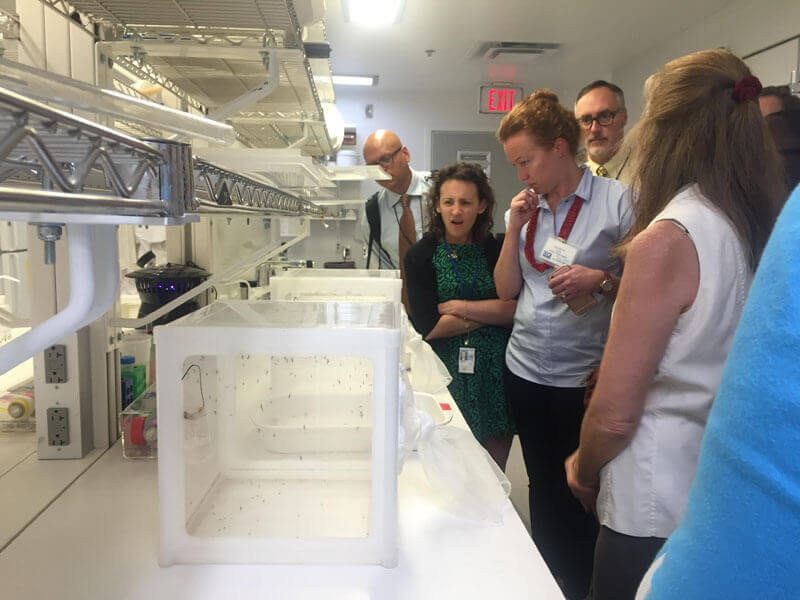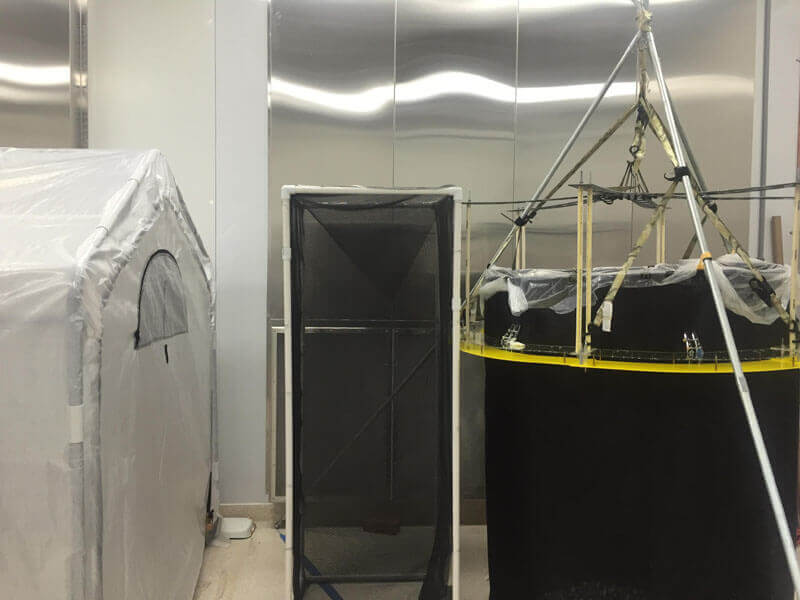 The delegation checks out the mosquitoes that CDC is studying at its lab in Atlanta. Photo: Courtney Carson/GHTCLast month, Global Health Council (GHC) and PATH led a delegation of global health advocates to the US Centers for Disease Control and Prevention (CDC) headquarters in Atlanta.
The delegation checks out the mosquitoes that CDC is studying at its lab in Atlanta. Photo: Courtney Carson/GHTCLast month, Global Health Council (GHC) and PATH led a delegation of global health advocates to the US Centers for Disease Control and Prevention (CDC) headquarters in Atlanta.
Since the founding of CDC more than 70 years ago, this US federal agency has played a vital role in global health. Its laboratories routinely work with
some of the most deadly germs in the world.While many Americans tend to only hear about CDC during the flu season or epidemics like Ebola and Zika,
the agency leads an impressive array of efforts that are vital to protecting the lives of US citizens and promoting the health and security of communities
around the world.
The delegation of advocates met with leaders across the agency’s divisions, including Dr. Tom Frieden,
Director of CDC, and Dr. Rebecca Martin, Director of the Center for Global Health, to learn more about CDC’s work and to share their perspectives from Capitol Hill. They gained new insight
into the agency’s science, policy, partnerships, and evidence-based public health programs, and learned more about the agency’s work in immunization,
health research and development (R&D), global health security, HIV and AIDS, tuberculosis, and malaria. The delegation also had the opportunity to
tour the CDC’s Emergency Operations Center and the Insectary and Parasitic Diseases Laboratory.
They ended their trip with a presentation to CDC staff on how their global health advocacy efforts in Washington, DC support the CDC.
We asked the delegation of global health advocates to share what they learned from the trip. Here’s what they had to say:
“CDC’s Global Disease Detection program detects 30–40 outbreaks a day. The reason we don’t hear about those outbreaks—and why they
don’t transform into epidemics and pandemics—is due to CDC’s swift response and ongoing capacity building programs that train local epidemiologist
to detect, prevent, and respond to new and emerging disease threats.” — Bob Noziglia, Lutheran World Relief
“Every CDC center is involved with Zika. It’s the most complicated response they’ve ever mounted, particularly because this is the first
mosquito-borne disease with fetal birth defects since Rubella. But CDC is coordinating its response with other agencies, including a CDC-designed diagnostic
that has been distributed to more than 100 countries around the world alongside lab training to use it.” — Lissy Moskowitz, Gavi, the Vaccine Alliance
“The world is on the verge of one of the greatest public health achievements in human history: the eradication of polio. CDC has played
a key role in these efforts, helping to develop a global network of polio surveillance, health workers, and laboratories that have become the backbone
of many developing countries’ health system. This infrastructure goes beyond polio to support a wide range of essential health services, including
providing vitamin A supplements, measles vaccinations, and surveillance of other diseases, like neonatal tetanus, and CDC continues to play a key role
in ensuring health services continue.” — Brian Massa, United Nations Foundation/Shot@Life
“CDC’s greatest resource is their people. Staff have an incredible career longevity—spending decades with the agency—which results in a depth
of expertise across global health issues, tight coordination across teams, and development of unique skill sets. For instance, CDC has two staff that
can identify unknown pathogens within an hour—morning, noon, and night—while others help countries with surveillance, lab capacity, and
training, or serve as key health advisors across multilaterals. This is one reason CDC is internationally recognized as “the world’s 9-1-1,” serving as the first line of defense for health departments and ministries globally.”
— Brandon Ball, PATH
“Unless Congress acts, funding for global health security at CDC will reach a fiscal cliff in FY19. To truly build and sustain the global
networks to prevent, detect, and respond to disease threats, predictable long-term funding is needed; while emergency supplemental funds are valuable,
they often come too late. Targeted, but flexible funding is needed so that local experts are resourced to act quickly to stop threats in their tracks.”
— Erin Fry Sosne, PATH
 The delegation checks out the mosquitoes that CDC is studying at its lab in Atlanta. Photo: Courtney Carson/GHTC
The delegation checks out the mosquitoes that CDC is studying at its lab in Atlanta. Photo: Courtney Carson/GHTC
“CDC's malaria and parasitic disease program not only conducts research to advance new diagnostics, vaccines, and countermeasures for malaria, but also works to make sure we are using existing malaria interventions effectively. In their insectary, CDC tests bednets to determine how many, and where tears and holes can exist before the nets are rendered ineffective. This work
is vital to leveraging US investments in the Presidents Malaria Program and ensuring we are using US global health funds responsibly and productively.”
— Erin Will Morton, Global Health Technologies Coalition
“CDC’s Center for Malaria and Parasitic Diseases works every day to improve treatment and develop new tools to address diseases that kill an estimated 534,000 people worldwide, but many Americans never see up close—neglected tropical diseases (NTDs).
Not only does CDC leverage donations from pharmaceutical companies to administer drugs for treatable NTDs at less than fifty cents per person per year,
but they also conduct research to develop new diagnostics and treatment regimens to more effectively combat hard or expensive-to-treat NTDs. For example,
CDC is working to transform a laboratory diagnostic for NTD schistosomiasis to a point-of-care urine test that is both more cost effective and more
appropriate for use in low-income, rural settings where the disease is most prevalent.” — Courtney Carson, Global Health Technologies Coalition
“Through the CDC Foundation, CDC is able expand the reach of its work through partnerships with corporations and individuals. Established by Congress as an independent nonprofit organization, since 1995 the CDC Foundation has raised over US$680 million, launched 800 programs around the world, and interacted with over 200 private sector entities. Most recently, through its Global Disaster Fund, the foundation raised $56 million from donors to assist with the response to the Ebola outbreak.”
— Lanice Williams, Global Health Council
“Although CDC had been working on the global response to HIV and AIDS since 1999, PEPFAR changed how CDC worked globally. With the inception of PEPFAR in 2003, CDC expanded its global work by opening more country offices and working closely with ministries of health. Today, through its regional offices, CDC continues to monitor Ebola in West Africa, trains epidemiologists through its Field Epidemiologists Training
Program, and work on the Zika response. And its work in PEPFAR continues: providing over 7 million men, women, and children with antiretroviral
treatment (ART) and care, as well as support for 5 million orphans and vulnerable children and the training of over 140,000 health care workers.”
— Danielle Heiberg, Global Health Council
“Through the use of
lab technology advancement, CDC has significantly driven down the cost of genome sequencing testing. CDC’s Advancing Molecular Detection (AMD) initiative
focuses on using the latest technology advances in pathogen identification to protect Americans from infectious disease outbreaks. This initiative
is fundamentally changing how CDC scientists conduct lab work and diagnostics on diseases such as tuberculosis, malaria, Zika, and
tropical diseases such as leishmaniasis, and by providing a thousand times more information in a shorter time frame.” — Karen Goraleski,
American Society for Tropical Medicine and Hygiene
This blog was originally published on The Collective Voice, the blog of the Global Health Council.


